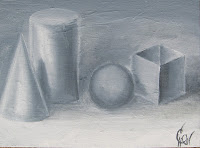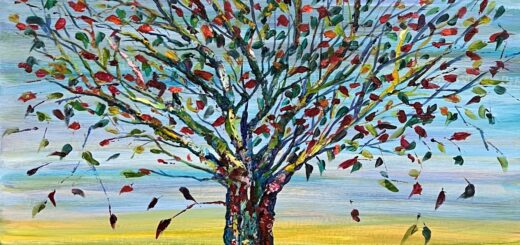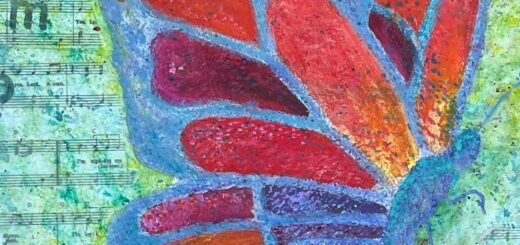Gray Areas in Art and Life

Gray Areas in Art
Gray areas in art and life can be both a challenge and a beautiful balance. As I worked on this practice exercise below, the following musings rambled through my brain and while they did, I grew. I am still growing in these thoughts and invite your comments and company in the process, learning to be at rest with just gray.
I always encourage my new art students to purchase a limited set of oil paint colors including white, but not black. For how to mix paint to get colors, see my mixing oil paint post. Black straight from the tube is heavy and over powering in art work and the desired effect can be achieved by mixing the colors on the Palette Knife Oil Paint Supplies post just as easily, without ruining the piece. Plus, mixing black from “scratch” so to speak, is great practice. The oil colors I recommend starting with are as follows:
French Ultramarine
Cerulean Blue
Alizarin Crimson
Cadmium Red Hue
Cadmium Yellow Deep Hue
Cadmium Yellow Hue
Titanium White
Gray starts with black
Gray in Art, is the result of mixing black and white. To do that, we need to start with a good beautiful black. There are several ways to arrive at black or “almost black,” which I prefer anyway. One way is to mix equal parts red, yellow, and blue. Another way is to mix complementary colors (opposite each other on the color wheel). For example; Purple and yellow are opposite each other, so mixing those will get black. Other options are mixing red and green, or blue and orange. Mixing brown and blue results in a rich black as well. Once this is done, place a blob of Titanium white on the palette and add a tiny toothpick amount of your mixed black then mix thoroughly into the white with a circular motion using your palette knife. Remove part of the light gray and add another small amount of black and mix again, resulting in a bit darker shade.

Repeating the steps of adding black to a portion of your gray mixture several times will give you several different shades of gray to work with. Left is a practice example done only with red, yellow, blue and white oil paint and a palette knife.
Gray Areas in Life
As I look at the piece above and think about life, I’m reminded of the verse from 1 Corinthians 10:23-24 . It is the perfect illustration of how gray areas in life can be navigated. There are so many online posts and books about this with tips on how to know if something is sin or not and exhortations to not turn spiritual gray areas into black and white issues. One post I found was called, “Pastors Keep Your Gray Areas To Yourself,” which was particularly interesting.
Let’s back up a moment for some clarity. In the process of creating the gray painting above, I started with white, added black and it became gray. I can take that same gray paint and add all the colors I want but it will never again equal complete black, because there will still be some white in it. I could take the gray paint and add white, and no matter how much I add it will never become pure titanium white again. Gray is the finished result and with all the shades employed, a composition is formed and perceived. It is complete. It is impossible to turn the mixed paint back into black or white, it is supposed to be gray and stay gray.
Resting in the Gray
The same is true in life. I think there are some gray areas in scripture left unclarified by God possibly on purpose, and where we error, is in trying to make those things black or white. When we focus on something gray, and try to make it black or white, or even just a darker gray or almost white, we are either trying to get as close to sin as possible without sinning or burdening someone else with our legalistic convictions to justify our own rightness. Both of these get us into trouble, cause needless conflicts and invite great harm to others and ourselves.
Gray is not the same as neutral or nothingness, it has value and is that way for a reason and we can be at rest with it. In art, gray adds contrast and shadow to create depth and definition. In life, gray is the tension necessary for us to grow in compassion, kindness and understanding. Some things in life are just gray. Why do we feel the need to undo or correct that? Maybe instead of trying to make the gray areas in scripture blacker or whiter, we should exist in the unresolved mystery of the gray. The rest of I Corinthians chapter 10 goes on to encourage us to do everything we do for the glory of God. This is a place of tension, yes, but if we really live that way, we are going to be seeking the good of others and not ourselves. That is the battle to fight friends.
There is no neutral ground in the universe. Every square inch, every split second, is claimed by God and counterclaimed by Satan.
C.S. Lewis
Can we be more concerned with living for God and serving and loving our brothers and sisters than what shade of gray all our sin is? Let us not try to figure out the mystery to every gray area of life and point those out to one another or hold others to our idea of what shade of gray is best. We are left to live in and navigate the mystery of these things, all the while loving God and others. We are exhorted that, “No one should seek their own good, but the good of others.” Let’s not seek our own good by trying to get by with as much sin as possible as long as it is not a very dark sin… and let’s seek the good of others by giving grace and trusting the Holy Spirit to lead and convict in gray areas as needed. Let’s just rest in the mystery of gray.




This is interesting.